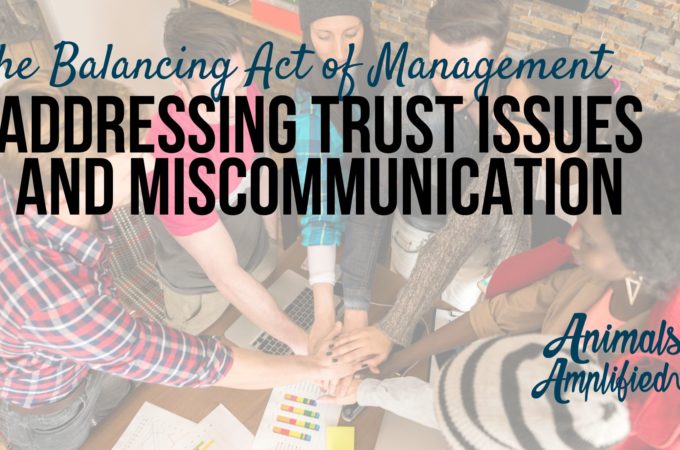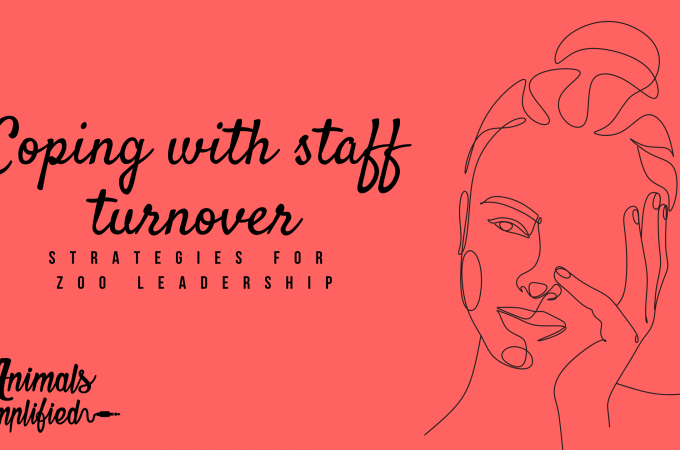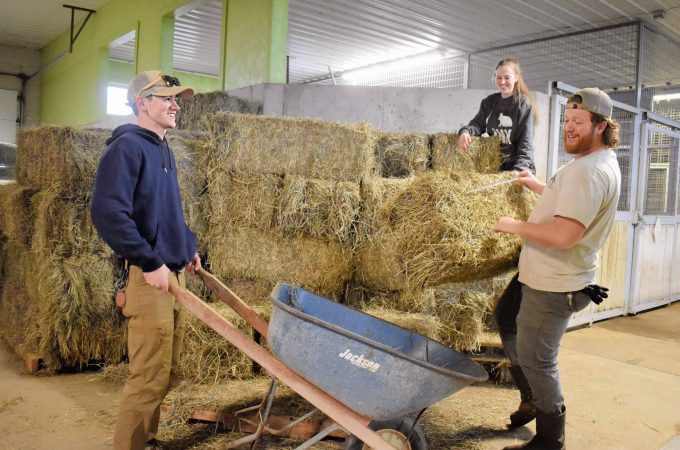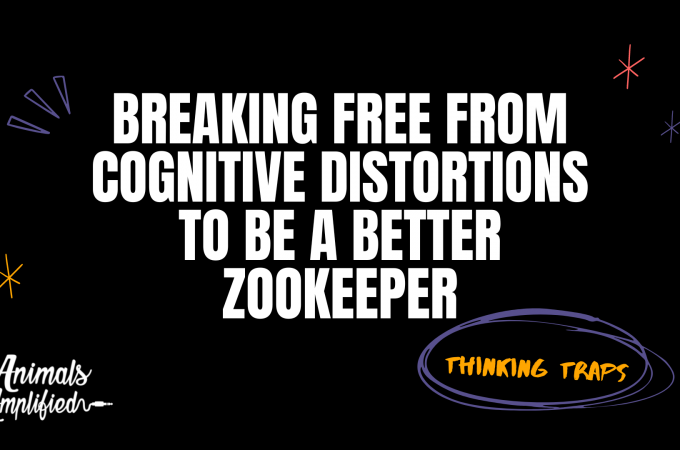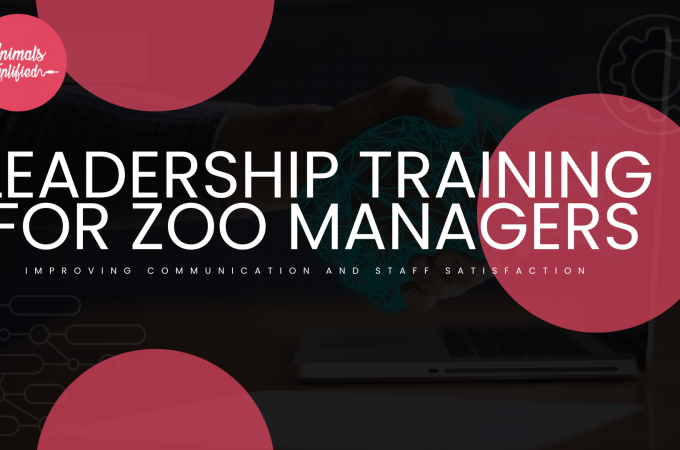
Zookeeper Zen: Mastering Collaborative Problem Solving in Animal Care
In a morning team meeting, Sarah shared, “Saucy the Centaur has a limp,” her voice had a mix of worry and determination. Saucy, a 45-year-old Centaur, was showing signs of distress, and Sarah felt obligated to advocate for her.
The meeting room erupted with opinions. Some zookeepers, echoing Sarah’s concern, believed it was time to schedule X-rays and delve into the root cause of Saucy’s discomfort. Others argued, suggesting that the limp could be attributed to the relentless pacing brought on by ongoing construction activities near Saucy’s enclosure.
However, amidst the escalating debate, the manager remained seemingly unfazed. The concern over Saucy’s well-being was met with an eerie calm that frustrated the room. “It’s like she doesn’t even care,” thought Sarah.
As discussions became heated, voices rose, and chaos ensued. This happened almost every time the team brought up a concern. They ended up on opposing sides, with frustration simmering among keepers and management. The meeting reached an abrupt, disheartening end, leaving the zookeepers dispirited, the manager seemingly indifferent, and Saucy’s condition unresolved.
In this atmosphere of confusion and discord, the very essence of teamwork appeared to crumble. The zookeepers left the meeting upset with each other and disillusioned with the management’s lack of decisive action. The concern for Saucy, initially a shared worry, transformed into a source of division.
Much of the day was spent whispering in the hallways. Sarah went around to talk to each keeper, trying to plead her case and convince them that something had to happen. We call this auditioning complaint in the zookeeper world, and it occurs when there isn’t a collaborative problem-solving strategy in place.
This opening scene sets the stage for exploring collaborative problem-solving strategies, illustrating the real challenges zookeepers face and the necessity of effective communication and innovative decision-making in ensuring the well-being of their beloved animal charges.
Three Methods for Collaborative Problem-Solving
Explanation and Steps: The 1-3-1 Method
The 1-3-1 method is a structured approach to collaborative problem-solving that encourages individuals to think through problems and solutions before raising them. It’s a simple yet powerful technique that empowers zookeepers to navigate complex challenges effectively AND efficiently. Let’s break down the steps and explore how zookeepers can seamlessly integrate this method into their daily routines:
1. Identify the Issue (1st Step):
- Prompt Observation: Begin by identifying the specific issue or challenge at hand. In our scenario, Sarah notices Saucy the Centaur’s limp during the team meeting.
- Clarity is Key: Ensure that all team members clearly define and understand the problem. This step establishes a shared understanding of the challenge. The problem is the limp.
- Root issue: Sometimes, the surface-level problem isn’t the root issue. Try digging deeper to make sure the root issue is also clearly defined. In this case, the root issue could be an injury caused by pacing or something else. Sarah should bring all possible causes to the meeting.
2. Generate Three Possible Solutions (2nd Step):
- Solutions: Ideally when concerns are raised to the team, there are already solutions brought forth as well. Sarah could bring three feasible solutions to the meeting for discussion, like scheduling an x-ray exam, moving Saucy away from construction, or monitoring her condition for the next week for signs of improvement.
- Diverse Perspectives: If solutions can’t be considered before the meeting, Encourage team members to brainstorm and contribute three distinct solutions to the identified problem. In the context of Saucy’s limp, this could range from the above three ideas to modifying Saucy’s environment to alleviate stress from construction noise.
- Foster Creativity: Emphasize the importance of creativity and diversity in proposed solutions. This step broadens the range of potential strategies to address the issue. In this case, Sarah’s manager would remind the team during this period that there are no bad or wrong ideas.
3. Select the Best Solution (3rd Step):
- Solution Ready: Typically, when problems are brought to the meeting, the team member raising them will have their three feasible solutions and the one they think is best, and why. Sarah had this when she asked for an X-ray exam, but without showing that she had thought through other possibilities, she created a void that the rest of the team filled.
- Objective Evaluation: If working through this process as a team, objectively evaluate each of the three proposed solutions. Consider factors such as feasibility, resource availability, and potential impact on Saucy’s well-being.
- Consensus Building: Engage the team in a discussion to determine which solution resonates most with everyone. The goal is to achieve consensus and select the best solution with the team’s shared values and goals.
How Zookeepers Can Apply 1-3-1:
- Raising Concerns: When concerns are raised, make it a habit to have completed 1-3-1 before bringing the concern to the team, share the root issue and three feasible solutions, and offer the why behind your proposed solution.
- Regular Huddles: Implement brief huddles or meetings to identify and discuss ongoing challenges. This ensures that issues are recognized promptly.
- Encourage Diverse Input: Actively promote participation from all team members during the solution-generation phase. This guarantees a rich pool of ideas.
- Objective Decision-Making: Train zookeepers to objectively evaluate potential solutions based on factors relevant to animal care, resource allocation, and overall zoo management.
- Consensus-Driven Approach: Foster a collaborative atmosphere where decisions are made collectively. The 1-3-1 method thrives on consensus, ensuring everyone feels heard and invested in the chosen solution.
- Understand the Who: It’s also important to understand who makes the final decision. A zookeeper might bring a 1-3-1 to their manager, or the team may develop a 1-3-1 in a meeting. However, the decision-making authority still often lies with the manager. Make sure everyone understands who will be making the final decision. We’ll discuss later how to ensure alignment and support with decisions made.
By adopting the 1-3-1 method, zookeepers can streamline their approach to problem-solving, ensuring a systematic and inclusive process that aligns with the best interests of their animal charges. It also shows managers how zookeepers think through problems and can help to build trust so the authority of future decision-making can be passed to the team.
Effective team communication is created when everyone understands how to present well-thought-out solutions and how decisions are made. This method enhances efficiency and promotes a sense of collective responsibility within the zookeeping team.
Explanation and Steps: The Brainstorming Method
The Brainstorming Method is a dynamic and time-efficient approach to problem-solving that harnesses the collective creativity of a team. It’s designed to navigate challenges swiftly and effectively, allowing zookeepers to address issues promptly. Let’s delve into the steps of this method and explore how zookeepers can seamlessly integrate it into their collaborative problem-solving toolkit.
1. Time Allocation (1st Step):
- Time Consciousness: Begin by deciding the total time available for the discussion. This could range from a quick 5-minute huddle to a more extensive hour-long session based on the urgency and complexity of the issue. In the case of Saucy in the morning meeting 5 minutes might have been appropriate
- Divide and Conquer: Divide the allotted time into three distinct parts. For example, in a 10-minute meeting, allocate 2 minutes for issue clarification, 6 minutes for brainstorming, and 2 minutes for solution ranking.
2. Clarify the Issue (2nd Step):
- Root Cause Exploration: Dedicate the first-time block to thoroughly understanding and clarifying the issue at hand. In our scenario, identifying the root cause or all possible causes of Saucy the Centaur’s limp.
- Open Discussion: Encourage open communication among team members to ensure everyone shares their observations and perspectives.
- Questions only: A good rule of thumb for this portion is only to ask questions. While anyone on the team can answer the question, this isn’t a time for debate or jumping to solutions.
3. Brainstorm Solutions (3rd Step):
- Structured Brainstorming: During the second time block, adopt a structured brainstorming format to generate potential solutions. The ‘yes meeting’ approach encourages positivity and ideation. In this format, there are no bad ideas. You can only say “yes” to an idea. You can also not say “but” only “and”. This fosters positivity and makes it safe to speak up.
- Foster Creativity: Promote an environment where all ideas are welcomed without immediate judgment. This phase is about quantity, not quality, encouraging diverse solutions. Encourage innovative group decision-making by not shutting down or putting down other’s ideas during this phase.
- No Constraints: During this phase of collaborative problem-solving, there are no financial or labor-related constraints. If you think sending Saucy to the moon will help her limp, put it on the list.
4. Rank Solutions (4th Step):
- Ease-of-Implementation Ranking: Utilize the final time block to order the generated solutions based on ease of implementation. From the least intrusive to the most, this ranking sets the groundwork for a strategic approach. For example, sending Saucy to the moon is pretty intrusive so it might be the last idea on the list.
- Quick Consensus: Aim for a quick consensus within the team on the ranked solutions, ensuring a collective decision on the next steps. Remember you can always return to a different solution if the initial one isn’t working.
5. Implementation (5th Step):
- Trial duration: Once the list is ranked, you will make a plan to implement the first solution on the list. Everyone must decide how long to trial that solution before moving down the list. For Saucy, maybe the first solution was to keep her in the barn on restricted movement for three days and see if it helped. This trial has a three-day duration.
- Follow-up Plan: Once the team has decided the duration for the first trial, decide who will follow up with the team to find out if it worked, when, and how they will follow up.
- Move Down the List: As each solution and its duration is tested, it should be easy to go back to your list for the next feasible solution and agree on its duration. Move down the list until the problem is solved or the problem changes and requires re-definition.
How Zookeepers Can Apply the Brainstorming Method:
- Quick Problem-Solving Sessions: Incorporate this method into short, regular problem-solving sessions. Rapid, focused discussions ensure that issues are promptly addressed.
- Structured Brainstorming Format: Train zookeepers in the ‘yes meeting’ format during brainstorming sessions, fostering an atmosphere of positivity and ideation.
- Effective Time Management: Teach the team to efficiently manage time during discussions, ensuring that each phase (clarification, brainstorming, ranking) receives adequate attention. Use a stopwatch to keep on track.
- Follow-up Protocols: Establish clear follow-up protocols, setting specific times to revisit and implement solutions. This ensures accountability and ongoing improvement.
By embracing the Brainstorming Method, zookeepers can harness their team’s collective intelligence, swiftly clarifying issues, generating creative solutions, and strategically prioritizing implementation. This collaborative problem-solving approach is an efficient way to generate innovative solutions. This method aligns seamlessly with zookeeping’s fast-paced and dynamic nature, allowing for efficient problem resolution while maintaining a positive and collaborative team spirit.
Explanation and Steps: The I.D.S. Method
The I.D.S. (Identify, Discuss, Solve) method is a systematic and collaborative approach to problem-solving that guides zookeepers through a structured process. This method ensures that issues are not only identified and discussed thoroughly but also resolved strategically and effectively. Let’s explore the steps of the I.D.S. method and how zookeepers can seamlessly integrate it into their collaborative problem-solving strategies.
1. Identify the Issue (1st Step):
- Observation and Recognition: Begin by actively identifying the specific issue or challenge. This is the stage where zookeepers pinpoint Saucy the Centaur’s limp during the team meeting.
- Clarity and Precision: Ensure a clear and precise identification of the problem, setting the foundation for a comprehensive discussion.
- 5 Whys: This is a great time to use the 5 whys. Ask why five times until you get to the root of the issue. In cases of injuries and illnesses, often we can’t determine a root cause without diagnostics so in Saucy’s case, we might ask why five times and make guesses to the root. Each guess could lead us in a different direction.
2. Discuss the Issue (2nd Step):
- Open Dialogue: Dedicate time to a thorough discussion of the identified issue. Encourage team members to express their insights, concerns, and perspectives freely. Effective team communication in these sessions requires respect for others’ ideas. Show that by asking clarifying questions and mirroring what you hear.
- Root Cause Analysis: Explore the root causes during the discussion, aiming for a comprehensive understanding of the problem. This is often a useful time to ask “what if” questions.
- Swap Sides: If you find division or debate is occurring during this time, that’s a great thing. However, don’t let your ego get tied to your ideas. Keep them separate by switching and arguing against yourself on occasion. “What if I’m wrong?”
3. Solve the Issue (3rd Step):
- Strategic Solution Generation: Shift from discussion to proactive problem-solving. Engage the team in generating potential solutions to the identified issue.
- Detach your ego: To foster innovative group decision making just ask if your idea can’t be tied to your ego, your solutions can’t either. Remember it’s “us vs. that” and work to find the best solution, whether it’s yours or not.
- Collaborative Decision-Making: Encourage collaborative decision-making to select the most viable solution from the generated options.
- Identify the WHO: Some decisions can be made by collaborative decision making process or by democratic vote. Others must be made by an individual, so be sure to clarify who is making the decision.
How Zookeepers Can Apply I.D.S.:
- Prompt Identification: Train zookeepers to promptly identify and report issues as soon as they arise. This ensures that challenges are addressed in their early stages. Have a format for raising issues or an issue list where issues can be posted to be discussed regularly.
- Inclusive Discussions: Foster an inclusive and open discussion environment where team members feel comfortable expressing their observations and concerns. Some of the tips discussed above, like switching sides and detaching ego, will help everyone feel safe to discuss.
- Systematic Problem-Solving: Guide the team through a systematic problem-solving process, emphasizing the importance of addressing both symptoms and root causes.
- Consensus-Driven Decision-Making: Instill a culture of collaborative decision-making during the solution phase, ensuring that the chosen approach aligns with the team’s collective vision.
Zookeepers can navigate challenges with a systematic and collaborative mindset by incorporating the I.D.S. method. This collaborative problem-solving approach ensures that problems are thoroughly understood and leads to strategic and effective solutions that benefit the well-being of the zoo’s inhabitants. The I.D.S. method serves as a reliable compass for zookeepers, guiding them through the complexities of problem-solving with clarity and efficiency.
Effective Team Communication Strategies
During any discussion, it’s important to keep a few effective team communication strategies in mind so that everyone feels safe to participate. Crucial Conversations is a great resource for ensuring that team and one-on-one discussions stay safe and gives good resources for identifying when conversations aren’t effective. Here are our top three:
1. Staying Focused on Solution – Positive Language Encouragement:
Using “Yes” meetings and applying rules like no “buts” only “and” are great ways to keep the meeting positive. With that said, effective team communication does include debate and organizational conflict. Reminding the team of the common goal of having the phrase “Us vs. That” posted in the team room can help keep those debates productive and solution-oriented.
- Solution-Oriented Language Tips:
- Avoid Blame: Instead of pointing fingers, encourage zookeepers to focus on solutions. Replace blame with a proactive mindset.
- Use “We” Language: Emphasize unity by using inclusive language. Phrases like “We can explore…” foster a sense of collective responsibility.
- Highlight Progress: When discussing challenges, draw attention to the progress made or lessons learned. This helps shift the narrative towards improvement.
2. Pouring into the Pool of Shared Meaning – Clear Communication Tools:
Collaborative problem-solving requires all team members’ voices to be heard. When we visualize a pool of information, similar to Dubmledore’s silvery memory bowl, we can allow everyone on the team to share their ideas or add to the pool of meaning without getting defensive. Remembering listening and understanding does not equate to agreement.
- Tips and benefits to a pool of shared meaning:
- Enhanced Understanding: Discuss how shared meaning creates a common understanding among zookeepers. This reduces the chances of misinterpretation and fosters a collaborative spirit.
- Building Trust: Shared meaning builds trust within the team, promoting a cohesive environment where members feel heard and valued.
- Encourage All Voices: Make sure everyone at the table gets a chance to share. Go around the room and ask each person to contribute. Sometimes starting with the enneagram numbers who are better at seeing both sides is important so they can share their thoughts without being swayed by others.
3. Remembering the Common Goal – Common Goal Visualization:
You cannot come to a consensus without a common goal. As mentioned before, our egos often become tied to our ideas. When you notice someone repeating themselves or politicking for their ideas, it’s a good time to step in and challenge their ideas or ask them to challenge themselves. Effective team communication is an important step.
- Questions to ask when things get heated:
- “What emotions are coming up for you?”
- “Can you argue against yourself?”
- “Have we lost the common goals?”
- “Are we still in Us vs. That mode, or have we moved against each other?”
By implementing these effective team communication strategies, zookeepers can create a collaborative problem-solving environment where positivity, clear communication, and solutions thrive. These approaches enhance teamwork and contribute to a thriving zookeeping culture where challenges are met with collective enthusiasm and determination.
Innovative Group Decision-Making
Having a good group decision-making process requires three things. First, there has to be space for creativity and innovation. Second, there has to be a decision. Lastly, there must be a system for getting everyone on the same page with the decision regardless of where they started. Nothing erodes a team faster than when a decision is made not everyone agrees on and politicking starts happening in the bathrooms, breakrooms, and keeper areas. Once all those things are considered, you will have an innovative group decision-making process.
Creating a Safe Place for Innovation
There are three methods leaders and zookeepers should keep in mind to encourage creativity and forward-focused brainstorming.
Promoting a positive atmosphere involves recognizing the influential role of positive language in decision-making discussions. Changes can be subtle and simple. As discussed before, by substituting the restrictive “but” with the inclusive “and,” there is an opportunity to foster a collaborative mindset and encourage teamwork.
For example, debating what could be the cause of Saucy the Centaur’s limp changing but when presenting a contrasting idea fosters collaborative problem-solving. One team member says, “I think she might have fractured her leg when she tripped over the big boulder last week.”
If another member disagrees, they might typically say, “But I think we should consider the fact that Saucy has been pacing more lately due to the construction.”
If instead, they say, “Yes, and I think we should also consider what effect the increase in pacing we’ve seen due to construction might cause when we’re brainstorming solutions.
This simple shift changes the tone and embraces various viewpoints instead of putting teammates against each other.
Another simple change is to change our mindset from “I need to prove my point and my position” to “Let’s have a Yes Meeting.” In the context of ‘Yes Meetings,’ a proactive approach is advocated, where team members embrace discussions with a mindset of agreement and collaboration.
Sarah might have started the conversation by saying, “Let’s have a YES meeting about Saucy’s limping. I’ll put 5 minutes on the clock for brainstorming.”
This mindset shift towards affirmation cultivates a positive atmosphere and unlocks the potential for creativity and synergy as everyone aligns their efforts toward finding effective solutions.
Collaborating instead of competing
Shifting from team members competing against each other to collaborating towards a shared decision involves instilling the mantra of “Us vs. That” to build team cohesion. Encouraging zookeepers to embrace this collective mindset, emphasizing unity over division, establishes a foundation for collaborative decision-making.
Excellent zoo leaders encourage effective team communication with questions and gentle reminders. In the case of Saucy the Centaur, when the debate and chaos broke out, a great manager would have stepped into the debate.
“It’s getting a little heated in here. I think we might have lost sight of our common goal. Remember, our team is trying to ensure Saucy has the best welfare and care. Let’s ensure we stay us vs. that focused instead of arguing against each other.”
Focusing on “Us vs. That” instead of “Us vs. Them,” the subtle shift in language fosters a sense of shared purpose within the team, emphasizing their collective commitment.
To further reinforce collaboration, great leaders highlight the shared responsibility of zookeepers towards the well-being of the animals. Remind the team that their common goal is to ensure the welfare of the animals under their care.
This shared responsibility becomes a unifying force, aligning team members towards a common objective and facilitating collaborative decision-making around the animals’ best interests.
Encouraging team members to switch sides of the debate is another effective strategy. This approach fosters empathy by urging individuals to step into each other’s shoes during discussions.
Sarah’s manager could have said, “Sarah, it seems you’re advocating for an x-ray exam while the other half of the team is advocating for contacting maintenance to see if we can delay construction until the limp has resolved. It’s time to switch sides. Sarah, why might contacting maintenance be a better suggestion than an exam.”
By experiencing different perspectives, zookeepers gain a more comprehensive understanding of various viewpoints, paving the way for enhanced teamwork. Additionally, this practice cultivates diverse insights, as individuals bring various perspectives to the table, contributing to a richer pool of ideas during the decision-making process.
What’s the process for making the decision?
Nothing is more frustrating than thinking you have decision-making power or authority and then finding out that someone else will make the decision. Leaders skilled in creating effective group communication understand the importance of sharing who, how, and when the decision will be made.
Sarah’s manager should have stepped in after Sarah made her original observation and said, “Alright, let’s problem-solve this. We’ll come up with a few options, and then I will take it to the veterinary team and make the final decision after consulting them. I’ll share the decision with the team in two days.”
Some decisions can be made democratically by voting, others may be up to individual keepers. Many times, the final decision rests on the manager’s shoulders because they will be taking responsibility for the outcome.
Regardless of how the decision will be made, ensure the team understands the process and their role.
Defend and Support Decisions that are Made
Defending a decision you didn’t initially support is a testament to your commitment to the team’s success. Once a decision is made, it becomes paramount for the entire team to rally behind it to maintain a cohesive and trusting work environment.
Publicly supporting the decision, even if it was not your preference, helps prevent the erosion of trust within the team. This involves avoiding private complaints in bathrooms and breakrooms, which can undermine team morale and cohesion. Instead, consider adopting a constructive approach by openly addressing concerns or seeking clarification within the team forum.
In moments of internal struggle to support a decision, engaging in introspection is valuable. Ask yourself, “What do I need to see or know to support this decision?” This self-inquiry encourages a proactive mindset, focusing on the aspects that could help align your perspective with the team’s decision. It might involve seeking additional information, understanding the rationale behind the decision, or identifying the long-term benefits.
By actively seeking the necessary insights, you contribute to a culture of open communication and continuous improvement, fostering a team environment where decisions are supported collectively, even if there were initial reservations.
By incorporating these innovative decision-making approaches, zookeepers can cultivate a culture of collaboration, adaptability, and continuous improvement. The emphasis on positive language, shared mindset, and clear communication about the process helps the team to face challenges with resilience and creativity.
Collaborative Problem-Solving as a Culture
Building a culture of collaborative problem-solving isn’t an overnight process. It requires small, subtle changes over time. Much like training a behavior for one of our animals. It also requires the team to be unified in a common direction and desire to have this type of culture.
The best zoo leaders embrace the skills of effective zoo communication and lead the team through organizational conflict in a way that supports excellence in animal care. However, this doesn’t require the manager or the supervisor to lead the process. Animals Amplified believes you can lead from anywhere.
Regardless of your title, you can bring these tools and techniques to your team and foster a collaborative problem-solving culture at your facility.
To learn more about communication and teamwork, check out our blogs or reach out to Animals Amplified to schedule a facilitated brainstorming session.

